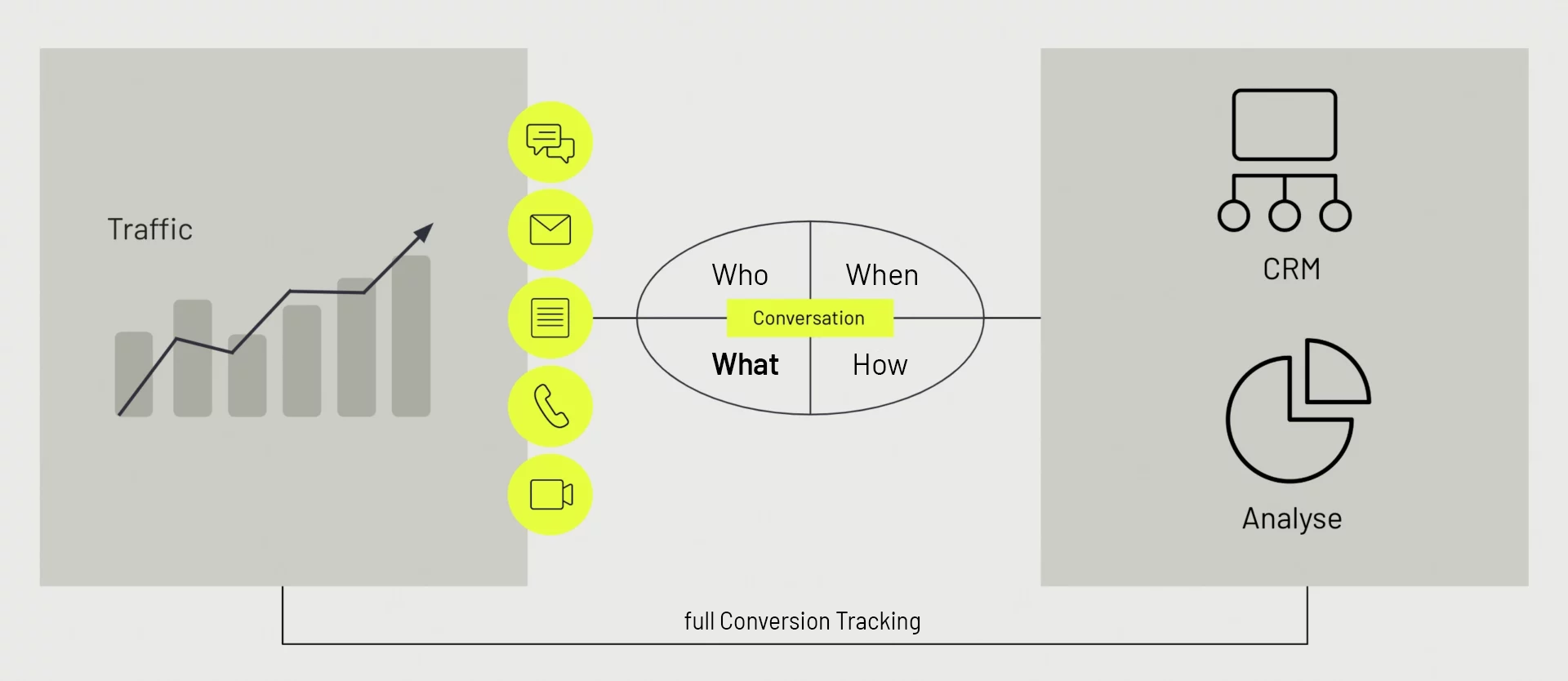Do you know the following situation: As a marketer – especially in the B2B sector – you are responsible for accompanying, educating and inspiring potential leads on their Customer Journey (CJ) until they express a concrete interest in buying – by transmitting further personal data such as their mail address or telephone number. Once this hurdle has been cleared, the prospect becomes a qualified lead who is then usually handed over to the sales team via a CRM or other technical tools to close the deal – especially in B2B. But the path to this point is often long and can only be mapped and managed with a stringent lead management process (LM) – including marketing automation tools.
When a person comes into contact with the company, this person acts as a bridge that connects marketing with sales and IT – but also with other departments such as support or corporate development. The goal is always: to use as much automation as possible to find relevant leads that can be converted into new customers. However, this requires a concrete, seamless and successful lead management, with which marketing managers can identify real prospects, interact with them and thus qualify them.
In the following article, we show which measures companies can take and how such a lead management process can be set up, optimized and successfully used in everyday work. In addition, marketers receive clear instructions they can follow to generate more and high-quality leads quickly and easily with relatively little effort – this pays off directly in terms of sales.
Table of content
- A definition: What is a lead management process?
- The starting point: looking at lead management across the entire sales funnel
- Step 1 – Target group identification: Who is my ideal lead?
- Step 2 – Lead generation: Creating attraction
- Step 3 – Lead Scoring: How far along is a lead in the sales funnel?
- Step 4 – Lead Nurturing: Creating added value
- Step 5 – Lead routing: Securing the next step
- The solution: Lead Management Software
- Concrete approach: matelso platform for a communication based lead management
A definition: What does a lead management process in marketing look like?
The term lead management encompasses all measures, activities and procedures that convert data that are still anonymous at the beginning of the customer journey into directly addressable leads. The complete process consists of five phases: Target group identification, lead generation (LG), lead scoring (LS), lead nurturing (LN) and lead routing (LR).

The starting point: looking at lead management across the entire sales funnel
Every inquirer goes through four phases along the way:In order to successfully, sustainably as well as continuously ensure the creation of inquiries for marketing and sales, the first stage is always the following: Leads are people who provide a company with their contact details for future essential interaction.
But why do people give their contact details? For this, marketers must always keep in mind not only the customer journey, but also the sales funnel. In other words:
Every inquirer goes through four phases along the way:
- Awareness phase – users are attracted and inspired by the website and other content
- Consideration phase – visitors to the website and other offers go through their personal decision-making process and are converted to leads via CTAs (Call-to-Actions: forms, downloads, etc.)
- Transaction phase – contacts are optimally addressed via the CRM and converted into buyers/customers by the sales department
- Customer loyalty & engagement phase – customers become advocates and multipliers through further interaction and nurturing
Across all these phases, the key is to take people on their journey from non-qualified inquirer to the status as a lead to contract closure throughout the LM process and provide them with the information they need at each waypoint to take the next step in the funnel – blog posts, webinars, social media, SEA, websites, landing pages, etc.

The sales funnel – the basis for an efficient sales system.
However, the marketing and sales departments must always work together seamlessly and without ego. Only then can a strategically planned LM process really generate success.
Fun Fact: Within the term “lead” there are two subcategories:
- Marketing Qualified Leads (MQL): a verified prospect that has their contact details on file and is passed from the marketing team to the sales team – they have gone through the entire assessment process.
- Sales Qualified Leads (SQL): A person who has been developed into a potential buyer by the sales team – and who is ready to buy.
How this works exactly and what marketing and sales should specifically consider when developing and implementing their individual LM process is explained in the next five steps:
Step 1 – Target group identification: Who is my ideal lead?
Nothing works without a clear definition of the target group. This is why this step always comes at the very beginning. Only if it is clear from the outset what kind of leads – e.g. which target groups – companies want to address, can the right measures be taken.
Personas are the tools of choice for this: in this way the ideal characteristics of a contact and their potential for concrete products and/or services can be easily worked out.
To do this, those responsible only need the following data:
- Socio-demographic information: What influences the potential customer – place of residence/environment, industries, business challenges, etc.?
- Decision-making processes: How do the target persons mainly inform themselves – blogs, search engines, classic media etc.?
- Conversion channels: Through which channel do I draw the most leads – website, call, media, social media etc.?
Important: Decision-makers should put themselves in the heads and life/work realities of the respective target group and offer potential buyers or interested parties actual added value and well-structured content – a change of perspective is necessary. Only when it is understood who the potential lead really is, what drives them and what they deal with on a daily basis, can an LM process ultimately bear fruit.
Step 2 – Lead generation: The way to generate more leads
LM processes are particularly relevant for B2B providers whose products and services require a great deal of explanation and involve high acquisition costs – with the resulting, correspondingly long decision-making processes and periods. Here, inquiry management can ensure throughout all phases that the prospective customer receives the information he needs at all times as well as appealing content. Leads are thus continuously made aware of further offers and content, which brings great advantages for both marketing and the sales department and continuously helps to generate and qualify new customer data. Because: The indicator by which it is measured whether lead management is making a valuable contribution is the number of new leads over a certain, fixed period of time.
Important: The task of marketing is to find out where the potential inquiries come from and what moves these people. Marketers do this best with original and useful content – this enables accurate tracking of the CJ and ultimately of all user activity.
In addition, marketers should create so-called lead magnets that specifically encourage website visitors to disclose further data (such as e-mail address, telephone number, etc.). In this way, they can create additional occasions for marketing activities and trigger direct actions, conversions and thus a stronger generation of leads.
A definition: What is a lead magnet?
Here’s what we mean with the term lead magnet: This tool is a product or service that is offered to prospects for free – in exchange for their contact details. Important here: Products or services offered – useful whitepapers, studies, how-to-guides, etc. – must have a high value for the target groups and attract them like a magnet. The more the lead magnet is aligned with the customer’s interests, requirements and business challenges, the more effective it is and the more qualified leads it can generate.
Here are a few examples of marketing content that are successful in a modern LM process:
- Whitepapers or webinars that are bookable or downloadable via a contact form – these are real lead magnets.
- Use mailings and social posts with links that can be measured via tracking tokens – this way, the click numbers of the individual leads can be precisely tracked and optimized if necessary.
- Use display/native ads and other digital advertising media that visualize the entire Customer Journey with the help of analytics tools and make it measurable – so marketers always know who came to their website or blog via which path. It also shows how leads organize their online searches and what they are looking for – an important factor to better understand them and optimize content marketing.
Step 3 – Lead scoring: How far is a potential lead in the sales funnel?
This is THE question in contact management: identifying actual sales potential and estimating when a lead can be addressed for a contract. In order to be able to determine this, it is absolutely necessary to bring all inbound contacts together centrally in one place, to make them analysable and to classify them in a scale. Only then can value-added scoring and qualification of leads take place.
The most common method: individual leads are assigned points along the sales funnel and Customer Journey depending on their actions on the website or their interaction with advertising materials – each company organizes this process individually. Added together, these give a value by which marketers and sales specialists can determine how far a lead has progressed in their decision-making process and whether they are ready for a conversation with the sales department and/or an offer. The higher the value, the more likely a closing.
Here’s an example:
A prospect reads a press article about a new software and also sees a display advertisement of the specific provider directly on the page. He clicks on the banner or on a link in a marketing mail of the company and is redirected to a landing page – that is then 3 points. There he consumes further information about products and services and presses the button ‘Prices’, which earns him 7 more points. The subscribed newsletter earns him 8 points again. And so it goes on. As soon as a lead performs another action or interaction with the provider’s content, this earns him more points until he reaches a very specific value that triggers direct contact by sales and the sending of an offer. The prospect is now far enough along the funnel to be converted into a buyer. Conversely, a lead can of course also have points deducted: For example, if he increasingly engages with job ads – job seekers are rarely buyers.
In this way, marketers receive very concrete information about how much a lead is actually worth. They can then use this information to optimize specific measures in their marketing strategy, tailor content more specifically to more focused target groups and adjust contact routes and intervals very precisely. The end result is a seamless, value-added marketing process that continuously generates more contacts and thus directly contributes to sales success.
Lead evaluation as a sub-process can be fully automated with the appropriate software solutions. The system recognises a lead and evaluates it throughout the entire LM process. Once a lead has reached a certain score, the next phase begins: lead nurturing.
Step 4 – Lead Nurturing: Enriching and generating new leads with more information
And here are a few tips to help leads on their way through the sales funnel:The basis for the lead nurturing phase is all the customer information collected and evaluated within the first three steps (targeting, LG and LS) – via which advertising medium or channel the lead came to the website, his interests, challenges, goals as well as his position in the sales funnel.
This data helps marketers and sales specialists to find out which lead has already reached the stage in the LM process where they can take the next step – closing the deal. They also find out who still needs information. In this way, inquiry management makes a valuable contribution.
But much more important: the information collected shows who is not quite ready yet and where “persuasion work” still needs to be done. This is where targeted lead nurturing measures come into play, which provide leads with additional, added-value content about the products and services. In this way, they are even better informed and convinced that one’s own offers are the most suitable for them.
To make lead nurturing successful, the following content is suitable:
- Further webinars and blog posts
- Detailed case studies
- Special offers and discounts
And here are a few tips to help leads on their way through the sales funnel:
- Find out which audiences respond to what kind of content and prepare appropriate material
- The tone across all communication channels (especially mail, call, video call or chat) should always be polite, friendly and personal to ensure maximum customer experience (CX)
- All communication products and direct exchanges should be accompanied by a clear Call-to-Action (CTA)
- And most importantly: the core of lead nurturing is to nurture and continuously evolve users from the first moment so that they can then be handed over to sales
Step 5 – Lead Routing: Handover to Sales
Once the first four steps have been taken, the next phase of the LM process begins: as soon as the leads are developed enough, they are handed over to sales. The important thing here is that there must be as much data on the respective lead available as possible so that the sales team in the company can take over seamlessly. This is where a valuable handover of the lead between sales and marketing takes place. The following questions must be answered for the evaluation:
- Where did the lead come from or how did he become aware of the website?
- What did he look at on the website and on which pages was he active
- What additional information has already been provided by marketing?
- Was there a direct exchange? If so, what was discussed or agreed on?
In order to assess whether a specific lead has really progressed far enough in the sales funnel, marketers can again fall back on lead evaluation. In this way, it can be validly checked that the inquirer has collected enough points to be interesting for the colleagues from the sales department.
The solution: lead management software
Successfully implementing all these steps is a real challenge for those who control and monitor lead management. To prevent these specialists from drowning in the flood of data and despairing over the multitude of tasks involved in managing and developing leads, it is worthwhile to purchase appropriate lead management software and use it on an ongoing basis.
These systems should have the following features so that they can really improve the process:
- The system should be cloud-based: this saves IT resources and reduces complexity.
- The system should shorten the toolchain: The MarTech landscape is more confusing than ever, with over 10,000 individual solutions – and more coming. The selected lead management solution should combine a correspondingly large number of tools in one.
- The system should provide valuable data on lead quality: this results in more relevant leads for the same marketing budget.
- The system should be seamlessly integrated with the customer relation management tool: this way, only evaluated data enters the CRM, which significantly optimizes lead nurturing.
- The system should be directly integrated with the analytics tools: this creates significant advantages for lead generation and campaign optimization.
Another aspect of such LM platforms that should not be neglected: a substantial increase in branding, image cultivation and CX via artificial intelligence and Big Data strategies. This allows a much wider range of data to be collected, analyzed and used to optimize the entire LM process.
One example: Ongoing direct conversations with specific leads can be analyzed for important keywords, voice quality or tone of voice and then assigned to very specific service, sales or marketing employees in real time – in some cases this is already possible without AI. The highlight, however, is the multitude of possibilities that intelligent algorithms offer, especially for lead nurturing. For example: optimized suggestions for improving a conversation in real time – branding messages, wording blacklists and whitelists or value-added content such as how-to videos or product data sheets. AI can also help identify leads with specific user behavior on the website – such as product page visits, shopping cart content, etc. – and then provide them with useful information directly and automatically when they contact the company. Targeted ‘fingerprint matching’ as well as automatically running, programmatic dialogue marketing strategies are thus also possible with the help of already existing customer information from the company’s own customer relationship management system. This all pays directly into contact management and ensures that leads progress faster and more purposefully in the sales funnel – and ultimately also buy.
Convert stronger: matelso platform for a communication based lead management

The matelso platform for a communication based lead management bundles all contact records in one central place and makes the data available to all stakeholders – company-wide and without silos.
With our matelso platform for a communication based lead management, we now offer a completely new, innovative approach:
With our cloud-based matelso platform, marketers get the best of both worlds (communication and LM platforms): They can bundle all contacts via conversational communication channels (chat, video, call, email, etc.) on their website in a central system and make them available to all stakeholders across the company. In addition, all relevant customer data can be integrated on the platform and then seamlessly transferred to other systems such as ad management and analytics tools.
This enables marketers to create the structures to significantly optimize their online marketing activities – every conversation is linked to a cookie ID and thus maps the user’s entire CJ. In addition, the direct integration into the customer relationship management solution enables the enrichment of already existing customer data with the collected interaction data. Marketers and sales staff now know not only which customer contacts the company when and via which channel, but also what was spoken or written – this is the basis for a significantly improved lead management process. And on top of that, the complexity of the infrastructure is significantly reduced, which saves resources and budget.
Companies generate the following advantages for themselves with the matelso platform:
- They increase budget efficiency and transparency throughout the entire marketing and lead management process.
- They gain value-added insights into their customer journey.
You can seamlessly transfer customer data collected in direct conversations to connected third-party systems such as analytics tools. - They create a simpler IT infrastructure to free up additional resources for LM activities – keyword: shortened toolchain.
As a result, the matelso platform provides managers with a solution that massively improves and accelerates all decision-making processes – and ultimately makes the entire company more successful.



